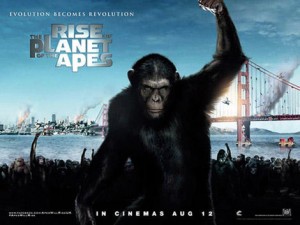
I finally saw Rise of the Planet of the Apes last night, and quite liked it. Much more than I thought, actually. The big climactic battle scene on the Golden Gate Bridge was probably the most entertaining thing I’ve seen on a movie screen in some time. A gorilla totally messes up a helicopter, and it’s spectacular.
Also, Andy Serkis’ motion-capture performance as Caesar, the chimp protagonist, was absolutely brilliant. The movie won my respect in that it told a story about a character who communicated almost entirely using facial expressions and body language. Caesar was vivid and well defined in the same way that WALL-E was, in that the filmmakers were forced to show, not tell. RotPotA uses CGI to tell a story, not to simply dazzle the viewer with effects.
That said, I had two small, quibbling issues with the movie. The first was a dumb, tacked-on story about humanity getting wiped out by an artificial supervirus, as opposed to a nuclear war, like in the original movies. This plot element takes place almost entirely after the credits, and I wouldn’t be surprised if it was hastily added in post-production as a rushed afterthought.
The other issue, though, was about San Franciscan geography. I enjoyed that the movie took place in a real American city as opposed to Any Town, U.S.A. What’s more, it took place in San Francisco, where I’ve spent a fair amount of time, and the big fight scene was on one of my favorite landmarks.
What bothered, me, though, was that my familiarity with San Franciscan geography kind of impeded my enjoyment of the movie. Towards the climax, Caesar and his gang of simian compatriots break out of a primate holding facility in San Bruno, south of San Fancisco. They climb up a hill and then look over the city.
After that, they’re suddenly breaking apes out of the San Francisco zoo. The zoo is on the western side of SF’s peninsula. According to Google maps it’s about twelve miles away from San Bruno. It sort of strains credibility that a horde of apes could go twelve miles in a big city and not be noticed, but okay…
Then, suddenly, they’re in downtown SF, up in the NE corner of the city. That’s about eight miles away. So, at this point the apes have covered over twenty miles of territory in a single afternoon, and so far not much of a response. As they are messing up downtown, Caesar espies the mighty Golden Gate Bridge.
I want to emphasize that even as I’m picking it apart, I really enjoyed the hell out of this movie. When the Golden Gate comes into the frame, though it’s as if the director is saying “Apes! To the widely recognized national landmark! Let’s have the climax THERE!” Because the climax couldn’t happen on Market Street or something. No one recognizes that.
The Golden Gate isn’t really near Downtown SF, though. The apes have to go another four miles through the Presido to get there. We don’t see that. It’s just downtown San Francisco and then BOOM! Golden Gate.t be on, you know, Market Street or something. It has to be on a landmark. If anyone were to ever bother with filming a movie in South Dakota, you can bet that the ultimate fight scene would take place at Mount Rushmore.
After that the apes are instantly in the Muir Woods, about ten miles away. I know I’m a stickler here, but quite frankly a horde of apes could not successfully cross through over forty miles of a populated area. The movie was so good, though, that I (almost) didn’t care.
I realize that movies and TV compress geography. In RotPatA, San Bruno, the zoo, downtown, and the Golden Gate are all close by because they need to be for the plot to happen. I get that. I also get that people who live in New York or LA are probably annoyed by how Hollywood has crunched and mangled their geography to a weird degree, with characters probably showing up at vastly unrelated locations on a regular basis.
This almost, almost makes me want to watch Zero Effect or Foxfire, just so I can see how movies have similarly cut up and re-edited Portland’s streets. Probably horribly, because no one out side of this city would care where things actually are.